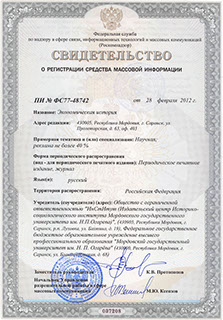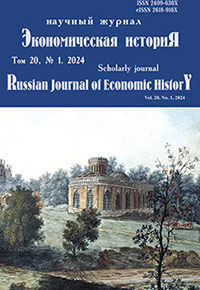Экономическая историЯ
Russian Journal of Economic History
ISSN 2409-630X (Print)
ISSN 2618-916X (Online)
Expert board:
- Scientific Council of RAS on economic history;
- Research and Educational Center «The economic history of Central Russia and the Middle Volga region» of Ogarev Mordovia State University;
- Center of Economic History of Lomonosov Moscow State University
Navigation
Certificate of registration

ISSN 2409-630X (Print), ISSN 2618-916X (Online)
DOI: 10.15507/2409-630X.064.020.202401.057-066
Lidia M. Kolbina1, Anastasia S. Osokina2
1, 2 Udmurt Federal Research Center of the Ural Branch of the Russian
Academy of Sciences (Izhevsk, Russia)
1 е-mail: lidakolbina@yandex.ru
2 е-mail: Anastasia.osokina2017@yandex.ru
The Beekeeping of the Collective Farm “Russia” of the Udmurt ASSR during the Ruling of L. I. Brezhnev
Abstract
Introduction. The article provides information on the economic performance indicators of the apiary: the area of honey plants, honey and wax productivity, the dynamics of the number of bee colonies, as well as agrometeorological conditions during the reign of Brezhnev (1964–1982). The purpose of the research is to assess the economic indicators of beekeeping in Udmurtia on the example of the collective farm “Russia” during the reign of L.I. Brezhnev. It is important for understand the impact on the current state of the industry in the region.
Materials and Methods. According to archival documents of a large collective farm “Russia” (reports), reviews of agrometeorological conditions of the Udmurt ASSR, the Central State Archive of the Udmurt Republic (CSA UR) P-567 Ministry of Agriculture and Food of the Udmurt Republic, P-1263 State Unitary Enterprise of the Udmurt Republic “Beekeeping of Udmurtia”.
Results and Discussion. The positive and active dynamics of growth and development of the economic efficiency of apiary production at all stages is illustrated – the honey-bearing base, building families and obtaining a high yield of honey, which is the basis for further development of the industry and increasing the pace of development. According to the annual reports of the collective farm, it is clear that buckwheat and flax were the main agricultural crops that were pollinated by bees. It was revealed that the number of bee colonies is subject to significant fluctuations over the years. At the beginning of the period under review, there were 890 bee colonies. Since 1967, on average, the dynamics of the number of bee colonies was relatively stable until 1973 (an average of 660 bee colonies). According to the annual reports, beekeepers have been constantly increasing the number of bee colonies by catching swarms and buying bee families. At the same time, the management of the farm strictly recorded the natural decline of families, which varied in different years and for various reasons. The maximum percentage of deaths was recorded in 1980 (41.2 %). An outbreak of varroatosis and nosematosis was registered in the republic in 1979–1980. It is established that the collective farm apiary of this farm is located in a central zone favorable for beekeeping. It has a variety of honey-bearing resources, and weather conditions are more positive than in other areas of the republic.
Keywords: economy, bee colonies, honeybee crops, commercial honey, acreage, honey productivity, wax productivity, cost price, agrometeorological conditions, collective farm
For citation: Kolbina L. M., Osokina A. S. The Beekeeping of the Collective Farm “Russia” of the Udmurt ASSR during the Ruling of L. I. Brezhnev. Ekonomicheskaya istoriya = Russian Journal of Economic History. 2024; 20(1): 57–66. (In Russ.). DOI: 10.15507/2409-630X.064.020.202401.057-066.
Acknowledgements: The study was carried out with the financial support of the Udmurt Research Institute of the Ural Branch of the Russian Academy of Sciences (state assignment No. 1021032424706-4-4-1.1).
© Ogarev Mordovia State University. History and Sociology Institute, 2017
68, Of. 411, Bolshevistskaya St., 430005, The editorial office of the scholarly journal «Russian Journal of Economic History»
Tel.: (8342) 24-25-90; 27-07-11, Fax: (8342) 24-25-90, E-mail: jurnal-econom-hist@isi.mrsu.ru
Designed by A. Napalkov, Email: napalkov@isi.mrsu.ru

